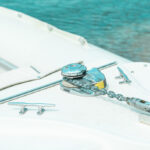Seasickness is a highly discussed topic, especially between the first time boaters, due to the fact that it affects each individual differently. Almost every passenger will experience some level of seasickness on a boat trip, especially on rough waters.
Seasickness, motion sickness at sea, has symptoms such as nausea, stomach cramps and vomiting. It is thought to be caused by the visual disorientation resulting from being on an object in motion (ship) competing against our body’s natural inclination for balance.
Whatever the technical cause, it can certainly be an inhibitor factor in your cruise fun. Fortunately, there are several ways to avoid seasickness or at least decrease the activity of symptoms.
1. Control your mind
If you are convinced that you are going to suffer from motion sickness, then it is more than certain you will. Especially if you have ever suffered from other forms of motion sickness (car, train etc.) the stress of your past experiences will influence you. Your mind can control everything. Try to be focused on your activities on the ship, and to avoid anyone else that may suffer from motion sickness.

2. Drug Remedies
There are many motion sickness medications, like Dramamine, Meclizine but you should choose the non-drowsy formula, so as not to fall asleep and lose the entertainment of the boat trip. A good alternative, and one of the most widely recommended remedies is Transderm Scop, a small patch that is worn behind the ear at least eight hours before exposure, with effectiveness for up to three days.
Extra tip: Choose for kids, less potent versions of medications and, of course, we recommend that you contact your doctor before giving your children any new medications
3. Avoid Becoming Anxious
Anxiety is one of the main reasons for seasickness. If the inclemency of the weather becomes inevitable, then all you have to do is to remain calm. The captain will provide you with some updates and the rest of the crew may take medicine. Enjoy your time and try to focus on all of the onboard entertainment, as you are on vacation after all.

4. Avoid the Cabin
As mentioned above one of the best ways to avoid seasickness is to be focused on your activities, thus you should spend as much time as possible outside of the deck. As long as you acclimate to shipboard life and have some activities, you will feel better.
Furthermore, use the horizon as a point to maintain your equilibrium and make your senses happy – your visual input will agree with inner ear.
5. Eat something
Some people may disagree, but most people feel better with a little bland food on their stomachs. Eat ‘safe’ foods that you know your body can handle. Avoid fatty foods or those high in salt and sugar. Bread, bagels, pancakes, green apple etc. are better than eggs and bacon. Also try to avoid coffee and orange juice, as they are acidic and may irritate your stomach. Generally, try to eat lighter meals.
Extra tip: Add peppermint and ginger to your diet while on board. They are great natural remedies to help reduce the risk of seasickness.
6. Choose your itinerary carefully
If you know that you get motion sickness, you should probably choose itineraries that go through calmer bodies of water. Itineraries that offer more ports is your best option, as it would be better, have fewer days at sea and more days in port with an opportunity to get off the ship. Sailing 2 or more days at sea is not ideal if your motion sensitive, so try to avoid it.
Just one last note: Keep in mind that not everyone is equally sensitive. There are mild, moderate, and extreme cases of motion sickness. Therefore, some of these tips may not work for everyone.
You should also check our blog post about the unique experience of a boat trip and how to enjoy every moment of it!








